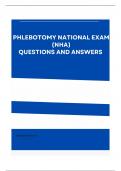, PHLEBOTOMY NATIONAL
EXAM (NHA) COMPREHENSIVE
QUESTIONS AND ANSWERS
Characteristics imperative to a phlebotomist - Ans Dependability, honesty, integrity, empa-
thy and compassion, professional appearance, interpersonal skills
Circulatory system function - Ans deliver oxygen, nutrients, hormones, & enzymes to cells
and transport cellular waste (CO2) to organs where they can be expelled
The two circulations - Ans Pulmonary & Systemic
Pulmonary circulation - Ans carries deoxygenated blood from the right ventricle to the
lungs and returns oxygenated blood from lungs to left atrium
Where does oxygenation take place in the lungs? - Ans alveoli
Systemic circulation - Ans carries oxygenated blood from left ventricle throughout the body
Upper chambers of the heart - Ans right and left atria
lower chambers of the heart - Ans right and left ventricle
tricuspid valve - Ans atrioventricular valve, situated between right atrium and right ventricle
**to remember this valve is on the right side of the heart-- people TRY to be RIGHT
pulmonic valve - Ans semi-lunar valve situated between the right ventricle and the pulmo-
nary artery
Mitral valve (or bicuspid) - Ans atrioventricular valve located between the left atrium and
left ventricle
aortic valve - Ans semi lunar valve situated between the left ventricle and aorta
Flow of blood through the heart - Ans Superior and Inferior Vena Cavae< Right atrium< tri-
cuspid valve< right ventricle< pulmonic valve< pulmonary artery< lungs< pulmonary vein<
left atrium< mitral (bicuspid) valve< left ventricle< aorta< rest of body
Three layers of the heart - Ans Endocardium, myocardium, epicardium
Blood vessels - Ans arteries, arterioles, capillaries, venules, veins, superior & inferior vena
cavae
aorta, arteries, and arterioles carry_____ blood _______ the heart - Ans oxygenated &
away from
venules, veins, and superior and inferior vena cave carry _____ blood ________ the heart
- Ans deoxygenated & back to
The average adult has ______ liters of blood - Ans 5-6
,Plasma comprises how much of circulating blood? - Ans 55%
Plasma contains.... - Ans proteins, amino acids, gases, electrolytes, sugars, hormones,
minerals, vitamins, and water
What percent of plasma is water? - Ans 92%
Formed elements comprise what percent of circulating blood? - Ans 45%
another name for red blood cells... - Ans Erythrocytes
What makes up the formed elements? - Ans Red blood cells, White blood cells, and plate-
lets
Another name for white blood cells... - Ans leukocytes
another name for platelets... - Ans thrombocytes
What comprises 99% of the formed elements? - Ans red blood cells (erythrocytes)
Where do blood cells originate? - Ans stem cells in bone marrow
How many RBCs are in a microliter of blood? - Ans 4.2 to 6.2 million
Normal life span of an RBS is... - Ans 120 days
Function of a leukocyte - Ans provide the body protection against infection
Amount of WBCs per microliter of blood - Ans 5,000-10,000
leukocytosis - Ans increase in WBCs
leukocytosis is seen when? - Ans cases of infection and leukemia
leukopenia - Ans decrease in WBCs
leukopenia is seen when? - Ans viral infections or chemotherapy
Five types of WBCs - Ans neutrophils, lymphocytes, monocytes, eosinophils, basophils
Average number of platelets per microliter of blood - Ans 140,000-440,000
Hemostasis - Ans process by which blood vessels are repaired after injury
Stage 1 of Hemostasis - Ans Vascular phase
Vascular phase - Ans blood vessel constricts slowing blood flow
Stage 2 of Hemostasis - Ans platelet phase
Platelet phase - Ans platelets adhere to inner lining of vessel to form a platelet plug
, Stage 3 of Hemostasis - Ans Coagulation phase
Coagulation phase - Ans converts platelet plug to a stable fibrin clot
Stage 4 of Hemostasis - Ans Fibrinolysis
Fibrinolysis - Ans breakdown and removal of the clot
Preferred site for venipuncture - Ans antecubital fossa
Three major veins located in antecubital fossa - Ans Median cubital vein, cephalic vein, ba-
silic vein
The vein of choice because it is large and doesn't tend to move - Ans Median cubital vein
What vein would you use in an obese patient when the median cubital vein cannot be
found? - Ans cephalic vein
What side of the arm is the cephalic vein located? - Ans thumb side
What side of the arm is the basilic vein located? - Ans inner side
unsuitable veins for venipuncture... - Ans sclerosed, thrombotic, and tortuous veins
sclerosed veins - Ans hard and cordlike
tortuous veins - Ans winding/crooked. susceptible to infection
Do you draw above or below an IV? - Ans below
How long should the IV be shut off before you can perform a venipuncture? - Ans 2
minutes
Is a phlebotomist allowed to shut off/turn on and IV? - Ans NOOOO
Complications associated with phlebotomy - Ans Hematoma, hemoconcentration, phlebi-
tis, petechiae, thrombus, thrombophlebitis, septicemia, trauma
Most common complication of phlebotomy procedure - Ans hematoma
What is a hematoma? - Ans blood accumulated in the tissue surrounding a vein
two most common causes of a hematoma... - Ans 1. needle going through the vein
2. failure to apply enough pressure on site after need removal
What is hemoconcentration? - Ans INCREASE in proportion of formed elements to plasma
What is the cause of hemoconcentration? - Ans tourniquet being left on too long
What is petechiae? - Ans tine NON-RAISED red spots that appear on skin due to ruptured
capillaries





